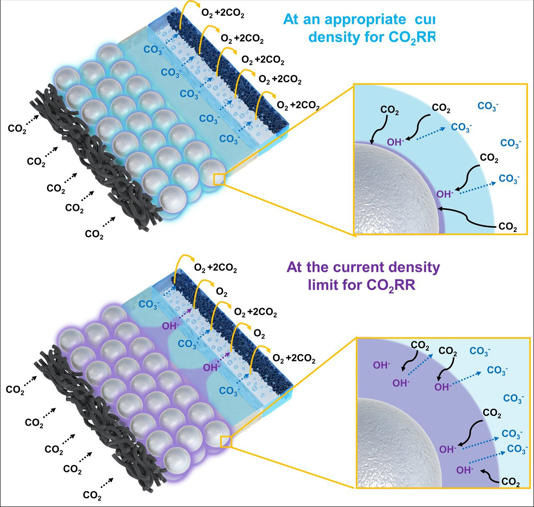Silver Catalyst: A Game-Changer in the Fight Against Carbon Emissions Through Efficient CO₂ Conversion
This diagram represents the silica-hydroxide cycle occurring during the electrochemical CO₂ reduction reaction using a silver-silica reduction electrode. The silica undergoes a weathering effect due to the hydroxide ions generated during the CO₂ reduction reaction, dissolving into a liquid state and then precipitating back near the anion exchange membrane, transforming back into silica on the reduction electrode, enabling a reversible process. This process prevents the hindered transfer of CO₂, allowing high-performance CO₂ electrolysis. Credit: Korea Institute of Science and Technology
Researchers at the Korea Institute of Science and Technology (KIST) have developed a silver-silica composite catalyst inspired by Earth's natural geochemical cycles.
This catalyst demonstrates reversible local pH control through a silica-hydroxide cycle, addressing performance issues in CO₂ conversion at high current densities.
The silver-silica composite catalyst showed nearly 100% selectivity even at a higher current density of 1 A cm⁻², compared to commercial silver catalysts that drop to about 60% selectivity at 800 mA cm⁻²
.Additionally, the catalyst boosted CO₂ conversion to CO by around 47%, achieving high efficiency even at elevated current densities.
This development is significant because:
It maintains catalyst performance without altering its physical structure, relying solely on a chemical approach.
It enhances CO₂ reduction performance and durability at high current densities.
It improves the commercial potential of Carbon Capture and Utilization (CCU) technology for electrochemical CO₂ conversion.
The research team plans to optimize production processes for high-efficiency catalysts and conduct long-term durability testing for potential application in industrial facilities, such as power plants and petrochemical factories.
This advancement in silver-based catalysts for CO₂ conversion aligns with global efforts to mitigate carbon emissions and develop sustainable energy solutions. It represents a promising step towards more efficient and commercially viable CO₂ reduction technologies.
The upper figure depicts the CO₂ reduction reaction at an appropriate current density, while the lower figure illustrates the CO₂ reduction reaction at a high current density in a diagrammatic form. In the CO₂ reduction reaction, hydroxide ions (OH⁻) are generated more abundantly at high current densities, combining with CO₂ and preventing its transfer to the catalyst surface, which reduces performance. Credit: Korea Institute of Science and Technology






The whole idea is Ludacris and a complete waste of silver. Realizing that carbon dioxide makes up .041% of the atmosphere should tell anybody with a brain that’s teeny weenie. It doesn’t add up to shit when it comes to the climate but it certainly feeds the plants so we can feed our faces. Global warming climate change propaganda is for stupid people, incapable of critical thinking and easily propagandized.